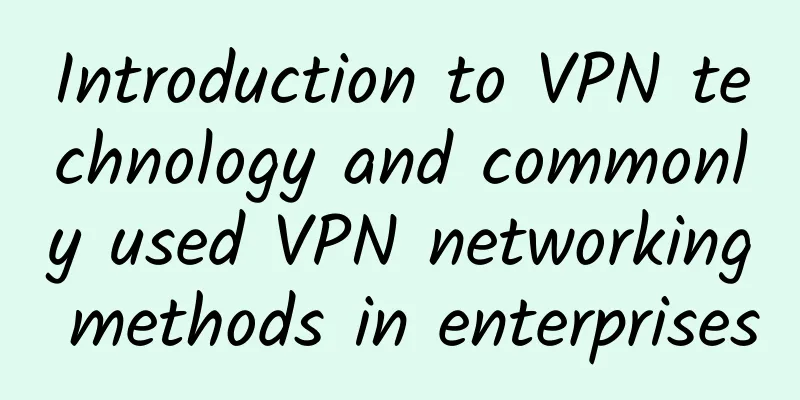Introduction to VPN technology and commonly used VPN networking methods in enterprises

|
VPN (Virtual Private Network) refers to the use of public networks, mainly the Internet, to establish a private network to transmit private data. What does this mean? We can explain it from some needs, because all technologies are created to meet certain needs. Imagine that the company has such a system, such as OA (Office Automation) system, financial system, which can only be accessed when you are in the company, and cannot be accessed once you leave the company. We call these systems internal systems, and their network environment is the internal network. Because these systems are very important to ensure sufficient security, these systems must not be connected to the Internet. Once connected to the Internet environment, they may be attacked, which is very dangerous. So what should we do if we want to access these systems when we are not at work? In theory, we can use a dedicated line, which is equivalent to a long enough network cable, to connect to the company's internal network to access them, but this method is of course unrealistic. The reality is that we can use the Internet, because the Internet has been built there, so VPN technology was born. It creates a secure private connection on the Internet public network. The public network is unaware of the existence of VPN, and there is no need to make any changes to the public network. VPN only uses the data transmission capacity of the public network.
According to the different network access methods, there are two main VPN access methods commonly used in enterprises, namely Site to Site connection method and Remote Access connection method. Site to Site is mainly used for connections between important sites of a company. For example, if a company has branches in other places, the employees of these branches will of course also need to access the internal system of the company headquarters. Site to Site VPN technology is transparent to end users, that is, the branch cannot feel the existence of VPN technology, because this method has established a connection through the VPN equipment of each site, so it will feel that the sites visited by each other are located in the same intranet. Site to Site VPN connection technology can only meet the connection between company sites, that is, users must be inside the company to use this technology to connect to other sites. If the user is away on a business trip, site-to-site VPN connection technology is not applicable. In this case, remote access VPN connection technology is needed. Remote access VPN generally requires the installation of a VPN client on the client computer in advance. The client varies depending on the specific implementation technology used. The most convenient way is to dial to the company's VPN gateway device by entering the VPN account and password through the IE browser. If the dial-up is successful, the client is virtually connected to the company's VPN gateway through a network cable, and then obtains an IP address to access the company's internal server. |
>>: Worth learning! 10 good habits of network administrators
Recommend
[Black Friday] CMIVPS: 50% off on all VPS annual payments, 30% off on top-up
CMIVPS has launched its last big promotion this y...
5G ToB development enters a golden period, and industry-specific networks enable digital transformation
[[386226]] 1. Introduction With the vigorous prom...
How to decide if Wi-Fi 6 is right for you?
There’s a lot of hype surrounding the next Wi-Fi ...
Detailed explanation of TCP packet sticking, packet unpacking and communication protocol
In TCP programming, we use protocols to solve the...
What exactly is the “computing power network”?
What is a “computing network”? Let’s get straight...
If you think 5G technology is overhyped, wait for 5.5G to arrive
Less than half of UK 5G users say 5G offers impro...
How to Make Ethernet Cable Longer
Looking to extend your existing Ethernet cable, o...
Top 10 SDN Solutions of 2018 (So Far)
Software is the front and center of the network w...
Seven technology trends for 2018 that IT pros need to know
As 2017 draws to a close, IT industry leaders are...
China's 5G connections have reached nearly 430 million, accelerating the exploration of vertical application markets
By the end of 2021, nearly 8% of the world's ...
How can operators easily get on the battlefield in the 5G era? 4.5G will take on the heavy responsibility
With the arrival of 5G, maintaining 2G, 3G, 4G, a...
Make network management more efficient! Quickly scan the LAN and obtain IP and MAC addresses in real time
Have you ever received a network failure alert la...
Linode: Free $100 for new users, cloud servers in 11 data centers starting at $5/month
Linode is a VPS cloud hosting company that has be...
DogYun New Year Promotion: 30% off on Elastic Cloud/20% off on Classic Cloud, starting from 16 yuan/month, top up 100 yuan and get 10 yuan free
The Lunar New Year is here, and DogYun has launch...
The fourth largest operator enters the market, and the 5G market welcomes a new growth point
It has been three years since my country issued f...



![[6.18] UFOVPS 20% off, top up 200 yuan and get 10 yuan, US CN2/Japan CN2 GIA/Hong Kong CN2 GIA optional](/upload/images/67cabe6b63f72.webp)





